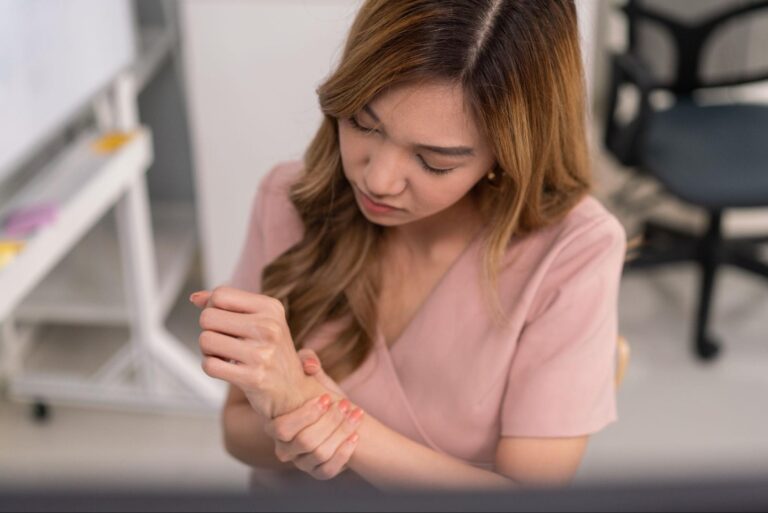Carpal tunnel syndrome (CTS) can turn everyday tasks into a relentless struggle, with the tingling, pain, and numbness in one’s hands and arms signaling a stark reality for many. Understanding this condition is the first step toward reclaiming your comfort and dexterity.
This blog post will guide you through what CTS is, how it impacts your median nerve, and why recognizing symptoms early can make all the difference in your treatment journey.
The road to recovery starts with knowledge and progresses through advanced care options. We’ll explore traditional treatments as well as minimally invasive options.
You’ll also learn tips for regaining and maintaining hand strength post-treatment, ensuring your hands can once again perform at their best without the shadow of discomfort.
Understanding Carpal Tunnel Syndrome (CTS)
Carpal tunnel syndrome (CTS) is a common condition where the median nerve, which runs from the forearm into the palm of the hand, becomes pressed or squeezed at the wrist. This pressure can cause a range of symptoms, most notably pain, numbness, and tingling in the hand and arm, which can be quite discomforting and affect daily activities and manual tasks.1 Over time, these sensations may become constant. When the space inside the carpal tunnel – a narrow passageway on the palm side of the wrist – narrows, it can irritate the nerve and lead to CTS.
Individuals experiencing symptoms should be aware of the various risk factors and causes of CTS. Repetitive hand motions, such as typing or assembly line work, can contribute to the development of the syndrome. Other factors include ergonomic issues, wrist injuries, and certain health conditions that may cause swelling in the carpal tunnel.
By understanding these triggers, individuals can take proactive steps to manage their risk of developing CTS or seek early treatment if symptoms arise.
Take A Symptom Survey
Carpal Tunnel Syndrome Management and Treatment Options
Depending on the severity of your symptoms, there are various treatment options available for CTS. These may include non-surgical treatments, traditional surgical treatments, and minimally invasive procedures.
The type of treatment that is most suitable for you will largely depend on your conversation with your healthcare provider, including the severity of your symptoms, your overall health, and your personal preferences. Your doctor may recommend one or a combination of treatments to manage your condition effectively.
Traditional Non-Surgical Treatments

If carpal tunnel syndrome is diagnosed early, there are several non-surgical treatments available that can alleviate symptoms and prevent further progression. These treatments generally emphasize lifestyle modifications, physical therapy, medications, and supportive devices such as a wrist splint.
Lifestyle Modifications
Simple adjustments to your daily routine can significantly decrease symptoms of CTS. Avoiding activities that overextend your wrist, taking frequent breaks, and altering the way you perform certain movements can minimize strain on your hand and wrist. Working with an occupational therapist can help you adjust your workstation or the way you do certain tasks that may be causing symptoms.
Physical Therapy
Certain exercises can help ease the symptoms of CTS by stretching the wrist and hand and strengthening the muscles, which can improve the median nerve’s function. Special therapeutic techniques such as nerve gliding exercises can also improve the movement of the median nerve within the carpal tunnel, further reducing symptoms.
Medications
For mild to moderate symptoms, over-the-counter medications such as ibuprofen or other nonsteroidal anti-inflammatory drugs (NSAIDs) can be used to relieve pain and inflammation. Prescription medications, including corticosteroids, can decrease inflammation and swelling that is pressing on the median nerve. These drugs can be taken orally or injected directly into the carpal tunnel.
Use of Wrist Splint
A wrist splint is often recommended to keep the wrist in a neutral position, especially at night. By preventing flexing or extending, splints relieve the pressure on the nerve, reducing the constrictive impact of the carpal tunnel. Most people wear a splint at night when symptoms such as numbness and tingling are most disruptive. In some cases, daytime use may also be beneficial, particularly during activities that usually aggravate your symptoms.
Traditional Surgical Treatment

In cases where non-surgical treatments fail to improve CTS, or the condition is severe, surgery may be an option. Traditional surgical intervention for CTS is known as carpal tunnel release (CTR), and it relieves symptoms by cutting the ‘roof’ of the carpal tunnel, the transverse carpal ligament, to relieve pressure on the median nerve.
Open Carpal Tunnel Release
Open carpal tunnel release is a traditional surgical approach typically performed using some form of general or regional anesthesia.
In this technique, the surgeon makes an incision in the palm of your hand over the carpal tunnel. This provides direct visibility of the transverse carpal ligament to be cut, thereby relieving pressure on the median nerve. The skin is then stitched back together, and the ligament heals, allowing more space for the nerve. This technique can require more recovery time than the minimally invasive approaches, but it has been used reliably for many years.
Recovering from traditional carpal tunnel surgery can be a long process, typically taking weeks to months. During this time, patients commonly experience discomfort and may be unable to return to their regular activities, including work, contributing to lost productivity and added stress. This lengthy recovery period is often one of the primary reasons many individuals may hesitate to opt for surgical treatment, despite the severity of their symptoms.
Minimally Invasive Techniques
Minimally invasive techniques offer several advantages over traditional open surgery for carpal tunnel release. These techniques typically involve smaller incisions, resulting in less tissue damage, reduced scarring, and faster recovery times.1-4
Additionally, minimally invasive techniques may lead to less postoperative pain3-5 and allow for quicker return to normal activities.1,3,4 Considering these benefits, individuals with carpal tunnel syndrome may find minimally invasive options to be a favorable alternative to traditional surgical treatment.
Let’s discuss the more widely known endoscopic carpal tunnel release option as well as a technique called carpal tunnel release with ultrasound guidance.
Endoscopic Carpal Tunnel Release
Endoscopic Carpal Tunnel Release is a minimally invasive surgical technique which typically results in less pain and quicker recovery than traditional open carpal tunnel release. A small camera (endoscope) is inserted through a small incision, either in the wrist or palm. At times, an incision may be made in both the wrist and palm. The endoscope guides the surgeon to the transverse carpal ligament, allowing it to be cut with minimal disturbance to surrounding tissues.
An advantage of this technique is that it allows the surgeon to visualize the nerve in front of the camera, potentially reducing the risk of damaging the nerve and speeding up the patient’s recovery time after surgery.
Carpal Tunnel Release with Ultrasound Guidance
Advances in medical technology have seen the development of minimally invasive techniques to the traditional carpal tunnel release approach. This technique offers a quick recovery time with minimal downtime post-procedure, making it a highly attractive option for those seeking quicker relief from the pain and discomfort of CTS without the lengthy healing process.1-5
This approach uses ultrasound to visualize the carpal tunnel and safely guide the treatment. During this technique a small device is placed under the skin and guided to the treatment area using ultrasound imaging. Once the device is in position, it releases a small blade that cuts the transverse carpal ligament safely and precisely. Once the transverse carpal ligament is cut, the blade is recessed back into the device and removed from the wrist. This technique leaves only a small puncture wound that typically does not require stitches.3,4,6
Get A Free Screening
While individual results may vary, this option offers several advantages for the patient. As the technique is minimally invasive, it may be performed in an office setting4,7 with local anesthesia.1,3,4,7 Because of its precision, ultrasound guidance reduces the risk of collateral tissue damage, often resulting in a quick recovery period and faster return to daily activities.1,3,4 This is a benefit when compared to the scarring and risk of complications usually associated with traditional surgery. Please discuss the risks and benefits of this procedure with your healthcare provider.
These procedures may not be indicated for everyone, so it’s essential to discuss with your healthcare provider on what approach would be most beneficial to you.
Complementary CTS Management Methods

Certain complementary and alternative therapy methods have been found useful in managing the symptoms of CTS. However, it is important to recognize that these options may not always be effective. Please consult with your healthcare provider before relying on any of the methods mentioned below.
Acupuncture
Acupuncture involves inserting thin needles at specific points in your body. It’s thought to relieve pain by releasing endorphins, your body’s natural pain-killing chemicals, and by affecting part of the brain that governs serotonin, a biochemical that can influence the nervous system.
Yoga and Tai Chi
Practices such as Yoga and Tai Chi can also aid in the management of CTS. These disciplines strengthen your upper body, improve your flexibility, and enhance circulation, all of which can help relieve CTS symptoms.
Diet and Nutrition
Adopting a balanced diet and adequate hydration can be surprisingly effective in managing carpal tunnel syndrome. A good diet can help reduce inflammation, repair nerve damage, and support overall hand and wrist health.
Certain vitamins, like B6, B12 and C found in fruits and vegetables like bananas, chickpeas, sweet potatoes, and citrus fruits, are particularly essential for nerve health and can help alleviate symptoms of carpal tunnel syndrome.
Likewise, foods that are rich in Omega-3 fatty acids, such as fatty fish, flaxseeds, walnuts, and soybeans, can help reduce inflammation.
Meanwhile, aim to limit foods that can cause inflammation like processed meat, sugary drinks, and fast food.
Remember that it’s always wise to consult with a dietitian or healthcare provider before making any drastic changes to your diet.
Post-Treatment Care and Hand Strength Recovery
The recovery of hand strength is a critical component in the healing journey following CTS treatment whether it be via surgery or minimally invasive techniques. Any post-treatment recommendations from a physician will vary depending on the type of treatment you’ve undergone, but physical therapy exercises may be needed.
Engaging in physical therapy and exercises might be a part of post-treatment. This may include a series of tailored exercises and potentially the use of therapeutic tools. They help restore your wrist strength and functionality and prevent scar tissue formation.
In the early stages of recovery, gentle movement such as opening and closing the hand can help to reduce swelling. As healing progresses, more strengthening and stretching exercises can be introduced.
After traditional surgery, some commonly recommended exercises include tendon gliding exercises, nerve gliding exercises, and strengthening exercises for the hand and wrist. It’s important to perform these exercises under the guidance of a physical therapist to ensure they are done correctly and effectively.
Guidelines to Prevent Recurrence
Preventing CTS from recurring mainly hinges on correcting the factors that initially contributed to the condition. Here are some general guidelines:


- Practice good ergonomics: If you’re at a desk for significant parts of the day, ensure you’re in a correct posture, your wrist isn’t constantly bent, and your equipment is set up ergonomically.
- Take frequent breaks: Rest your hands and wrists periodically if you’re performing tasks that involve repetitive hand and wrist movements.
- Stay healthy: Maintain a healthy weight and stop smoking. Both obesity and smoking can increase your risk of CTS.
- Exercise: Regular activity can improve your overall health and reduce your risk of repetitive strain injuries.
- Body mechanics: Using your whole hand—not just your fingers—to grasp an object can reduce the strain on your wrist.
Remember, each individual’s case might vary, and these suggested measures are general considerations. Always follow your healthcare provider’s advice based on your personal health and recovery situation.
The Importance of Early Diagnosis


Patient self-awareness plays a vital role in recognizing the early signs of CTS. This proactive approach can greatly enhance the likelihood of a favorable outcome and may open up a wider range of treatment possibilities.
Individuals who experience persistent pain, numbness, and tingling in their hands and arms should seek professional medical advice promptly. This is particularly important for those who engage in activities involving repetitive hand movements or poor wrist ergonomics.
When it comes to diagnosing carpal tunnel syndrome, doctors usually start with a detailed description of your symptoms, the pattern of your symptoms, and a physical examination of your hand, focusing on sensation and muscle strength. A wrist examination might also be conducted to check for any swelling, deformity, or signs of arthritis.
In addition, doctors may use specific tests such as a nerve conduction study or electromyography (EMG) to assess the electrical activity of your muscles and nerves. As an alternative to nerve conduction studies or EMG, diagnostic ultrasound may be carried out to visualize and measure the median nerve and identify any possible compression.
Early intervention can lead to more conservative treatment options and a reduced likelihood of requiring surgical intervention. Likewise, this can help to prevent permanent damage to the median nerve in the long run.
Which Option is Best for You?
Each person’s experience with CTS is unique, and therefore, treatments should be personalized to meet individual needs and circumstances.
There is no one-size-fits-all solution, and what works best may depend on the severity of your symptoms, your overall health, and your personal preferences. In some instances, a combination of treatments, like physical therapy paired with surgical or non-surgical interventions, may be the most effective.
Open communication with your healthcare provider is crucial to developing the most suitable treatment plan.
Take the Road That Leads to a Healthier Life with CTS

As we navigate through the complexities of carpal tunnel syndrome, from understanding its symptoms to exploring alternative treatment options, it’s clear that early intervention and alternative options can impact recovery and quality of life.
Living with carpal tunnel syndrome can undoubtedly be challenging, but it doesn’t mean that it should become a roadblock in your life.
By understanding the condition, implementing appropriate treatment strategies, and making necessary modifications in your life, you can help to manage CTS’s impact on your lifestyle and well-being. Through effective management, you can return to daily activities with minimal interruption and embark on a journey towards a healthier, pain-free life.
If you’re grappling with the discomfort of CTS, it’s time to consider a change in your treatment approach. Consider carpal tunnel release with ultrasound guidance and experience the benefits of a minimally invasive technique with a swift recovery.
Take the first step towards regaining your hand strength and comfort by scheduling a free screening to see if this minimally invasive approach is right for you.
MP04168rA





